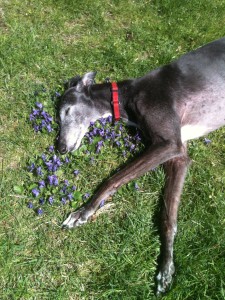
My house is quiet. It’s been six months since we said goodbye to Elsa our cat, and just three months since we did the same for Valentina, our dog. Having for nearly a year nursed them both through their twilight, we knew when Elsa left us in August that Valentina would likely not be far behind.
At their advanced ages, both Elsa and Valentina slept most of the day and were low key when awake; even in their younger years they both were of a rare quiet variety. Yet, I was unprepared for the absolute noiselessness of an empty house coming to bear. No kitty feet lightly thrumming the hardwoods above or below. No echoing, slow nail-clicks of lazy dog paws wandering from one soft bed to another. No ponderous bowl-lapping, no brief jangles of collar tags, no more distant sighs and sneezes. These tells of shared living with a pet are part of the atmosphere; barely audible, but their absence is deafening. What is missing is two life forces, leaving the house so very quiet.
Just as I memorialized Elsa, it is time to do the same for Valentina. To start, she was the best dog. The best dog. I know all you dog lovers think that you have the best dog. I’m sorry—respectfully—but you are wrong. Ask anyone who ever knew Valentina. She was the best dog ever. For that we gave her the best life and the best passing we could, at home, peacefully, with quiet dignity. And we hope that the last thing she heard was us whispering, “You are the best dog, baby girl.”
Born Captive
Valentina was born January 19, 2002, to a breeder of greyhounds somewhere in Florida. She was number 3 in the litter, or at least the third puppy to be scooped up for the customary ear tattooing. She was a purebred greyhound, a millennia-old sight hound breed bred for speed; Valentina specifically was bred to race to make money for her owner. She was an investment, a commodity, and chattel. Her first twelve to eighteen months was probably a period of learning how to live at a track, how to race on a track, to make money for her owner.
Living at the track meant eating grade 4-D meat and sleeping in a crate lined with newspaper. Aside from training, she would have resided in her crate for the majority of the day, and her crate would have been stacked on top of another crate (females’ crates atop males) making for a three foot jump up. Her paws only tread on sand.
Learning how to race on a track might have meant being trained with a live lure. Meaning, a small animal (rabbit?, raccoon?) presented, boxed up, to a pack of young greyhounds in hopes of triggering their natural high-prey-drive to give chase. She would learn how to wear a racing smock and basket muzzle, the latter meant to prevent injury from the inevitable nips of frenzied, fast dogs.
Races would end with a high-pitched signal, followed by the racers dunking in water troughs to cool down. Overheated sprinters who wouldn’t willingly take the plunge were hosed off for their own good, whether they liked it or not. (Based on Valentina’s extreme dislike for baths, the hose, and Lake Ontario, she must have been sprayed.)
A Loser Hits the Jackpot
Greyhounds bred for racing begin competing around 18 months old. Valentina Tate (racing name) raced at Melbourne Greyhound Park in Melbourne, Florida. She should have been very fast as is common for petite, light-weight female greys. She ran in 20 races… winning only one, and not even finishing another. We often speculated about those two special races; what happened on the track the day she won? A pile up? What happened when she didn’t finish at all? Just lie down in the sand?
Her bleak track record meant that her owner would not continue to put money into a loser, and so she was released to the greyhound adoption system. Valentina was spayed, given a thorough physical, and tested for prey drive (cat/small animal safe-ness).
Meanwhile, The Husband’s campaign to get a dog had succeeded like a slow-moving steamroller. A pudgy, snaggle-toothed Chihuahua named Bernie was our first try, but we lost him to another adopter. Somehow, The Husband learned about the local greyhound adoption group placing retired racers. The organization hosted a “Meet & Greet” at a nearby shopping center. One look into the big, serene eyes of a greyhound and I was hooked.
Several months later, following our accepted application and interview, including a home visit, we learned that our greyhound was on her way. We had been trying to think of names for our new household addition, but the universe had already named her; “Valentina” was due to arrive in Rochester on February 14, 2004.
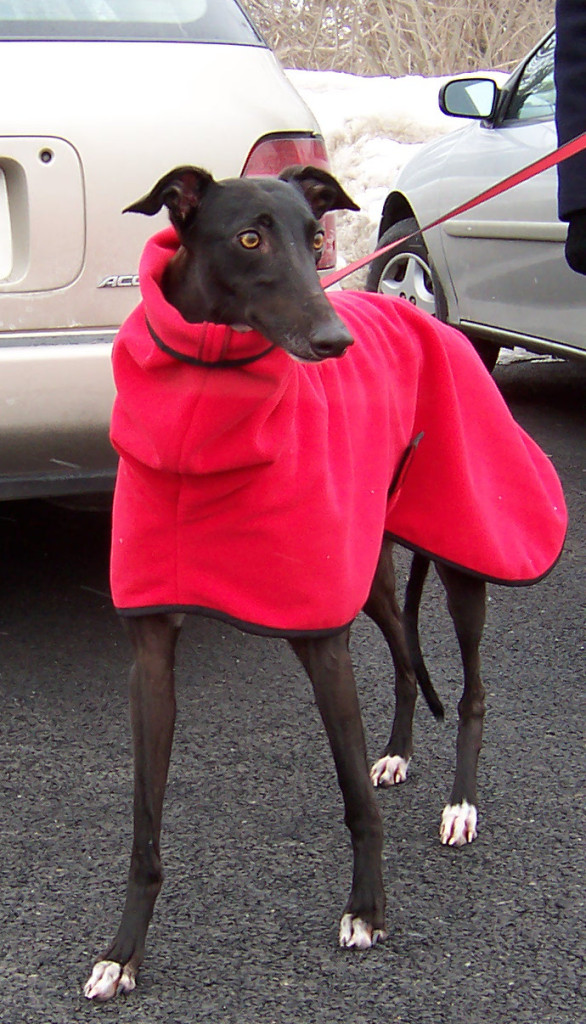
A Greyhound World
Adopting a greyhound is a big deal. These are full grown, large breed dogs, with none of the experiences of other adult dogs. Though crate-trained, they are not housebroken. They have never walked on a leash for pleasure, don’t know how to climb stairs, and have no context for clear glass. We had to teach her everything, including walking her over to storm doors and our china cabinet to gently tap her paw on the glass.
She housebroke within a day, and stairclimbing came soon after as the desperation to go out at potty time overcame any trepidation.
In a greyhound world, nothing is the same as for other dogs.
Greyhounds have very thin coats and low body fat, so require extra protection from cold weather. Valentina had three different coat garments: a hooded fleece, a fleece and nylon heavy coat, and a hooded raincoat, all in red.
Though a sight hound bred and trained to chase small, furry animals, Valentina did test small-animal safe, but we discouraged excited interaction between her and our cats. Other than the test, I believe she had never before seen a cat, because she would for the first several months completely avoid walking past Elsa and Moby. She would even avert her eyes!
In the same vein, greyhounds have never before seen other breeds of dogs. Surely canines have a similar enough odor to identify each other as “dog,” but that didn’t compute the first time Valentina came face-to-face with a bulldog. The stocky little guy waddled down a driveway and got right up in Ms. V’s business. She abruptly pulled her snoot away and stumbled backwards, tripping and faltering this way and that trying to avoid contact with this squat, no-snout, round-headed creature that smelled like a dog but sure didn’t look like one. I wish I had video, it was truly hilarious.
Greyhounds, though, are generally at ease around other greyhounds, and our one attendance at Greyhound Planet Day was an ‘a-ha’ moment: nearly 100 greyhounds were assembled in a parking lot preparing to walk a mile parade-style. Try picturing 100 golden retrievers assembled, or 100 Labradors. The “noble, gentle” greyhounds, as characterized by the AKC, were quiet and reserved. When one dog began barking, every greyhound handler turned to look in surprise. And, it was a passing golden retriever.
Speed 1: Off
We also had to acquire and find space in our house for a large wire crate. Greyhounds come crate trained and many, including Valentina, continue to happily use their crates throughout their lives. She loved hers and would snooze in her secured crate all day while we were out. In fact, as evening wore later, Valentina would commonly decide it was bedtime and leave us in the living room to bed down in her crate for the night. Only in the last 4-5 years did we stop leading her to her crate when we left the house; by then we knew all she planned to do while we were gone was sleep.
Once you understand that greyhounds are sprinters—which, by definition, means that they expend their energy in brief bursts—it is easier to understand their nickname, the 40 mile per hour couch potato. Greyhounds are LAZY. Throughout a day, Valentina slept more than Elsa cat. And when she did get up, it was often just to stretch and walk over to one of her other beds (she had four: one downstairs, in her crate, one in my home office, one in The Husband’s home office…plus the couch).
In her crate, on her beds, or on our couch, Valentina’s favorite mode of sleep is what is called among greyhound adopters “Dead Cockroach position”: on her back, all four long, reedy legs stretched to the sky. (Her bald belly could also suggest a boudoir pose.)
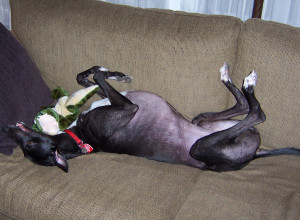
Valentina was a connoisseur of slumber. First thing in the morning, she would rise, stretch in an impressive, lithe, downward-dog, pad across the hallway to one of her other beds, collapse on it, and let out a long, satisfied sigh. A dog’s life, indeed.
Speed 2: On-ish
When she did decide to move, Valentina was lightning fast. In her prime, she would every evening at dusk race in a circle around our rather small backyard. She ran so fast that she wore a rut into the turf. Neighbors marveled at her speed. Squirrels cowered. And for good reason–Valentina was fast enough to snatch a fleeing squirrel right off of the trunk of our pine tree.
The Husband was the single witness the first time it happened. He says she grabbed Mr. Squirrel and triumphantly flung it exactly like she did her plush stuffed animals in the living room. Exactly. But just for a moment, because the greyhound’s goal is to capture, not maul. Once she had it, she left it on the ground and walked away. Her grasp was fatal, unfortunately. Cross my heart, we didn’t see a single squirrel in our backyard for months.
A few years later I witnessed Valentina snatching another dumb squirrel trying to tiptoe an escape across the top of our picket fence. She grabbed its tail and would have completely overpowered it, had I not shrieked my surprise. She was genuinely startled and so the squirrel got away. (Well, most of it. A gray puff of tail was left behind in the grass.) We didn’t scold her, though, because she was only doing what greyhounds have been bred to do for thousands of years: chase down small animals. She was good at that, but not at track racing.
Well-Trained
In training, it helps to have a dog that wants to please you, The Master, The Alpha. Valentina wasn’t a ‘needy’ dog, which, along with being super smart, could have spelled trouble. Maybe what she had was a level of reason uncommon to dogs. Or, she just didn’t care enough to misbehave. Plus, an affinity for snacks.
Though a blank slate for domestic behavior, it didn’t take much to train Valentina. We did take her to dog obedience class during her second spring with us. First up was teaching the Long Down. In a roomful of rowdy dogs, big and small, each owner had to command their dog to lie down and stay. The ‘stay’ was achieved by said owner hovering in a squat over their dog to keep them from getting up. Maybe this is out of vogue now, but the idea was to establish a gentle dominance.
A little dog that resembled a mop head took a while learning, requiring little more than a steady hand keeping her down. A large mutt, a stray brought back from a Caribbean mission by a young lady, was a bit more unruly. The young lady wrestled in the corner with that dog for the first three sessions.
Valentina? For our first class long down, I had her lie down (she had mastered sit and lie down pretty quickly – see “affinity for snacks”), then I got into hovering position. When she started to shift her weight, I got myself ready to gently keep all 50+ lbs of her muscle in place, but gave her enough room so she wouldn’t panic. With that extra room she rolled over on her side, put her head on the floor, and started a nap.
Did I train her? Or, was it that she couldn’t be bothered to put up a resistance? It’s hard to know for sure.
When a squirrel got into our house one winter, we cornered it in a spare room. Desperate to catch it, we brought Valentina in thinking she could at least flush it out or grab it. She lay down on one of her dog beds, and watched this squirrel ping around the room, her eyes following like at a tennis match. She didn’t move. Not even when the squirrel ran over her outstretched forelegs. Nothing. She wouldn’t even get up! In that moment, we realized that all our admonishing “Don’t chase the cat,” must have worked. Only, it extended to all small, furry creatures inside the house.
Food Motivated
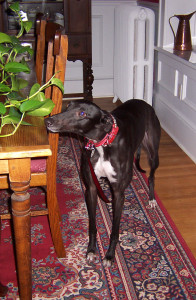
Then there was food. Valentina was never given any ‘people’ food, so she never seemed to put together that what we were eating might be tasty. Since our dining table was at her eye level, this was a good thing. And, since countertops were roughly the likely height of her crate at the track, we were spared what was called ‘counter surfing’; many the lanky greyhound has been known to hop up on a counter top to help themselves. (Our three foot high picket fence out back should have also been a cinch for her to jump. She either didn’t know she could do it, or just didn’t care to leave.)
On Day 1 with Valentina, we gave her a large dog biscuit at her bed, then proceeded to sit down and eat our dinner. And so it went every day for the next twelve years. As we set the table each evening, she would trot over to her bed and patiently wait for her biscotti, as we called it. She would gnaw and crunch it, lick up the crumbs, wander in one slow lap around the dining room table, take a long splashing drink of water, then return to her bed, most likely to flop down and belch.
The one morsel of ‘people’ food that Valentina did get, frequently, was popcorn. As we settled into watching a movie, we would wait for her to look away then would loft a few kernels of popcorn over to her bed, because we didn’t want her to see us giving her something we were also eating. It was like manna from heaven! She loved it!
She must have thought we were awfully cute; it didn’t take long before we noticed that Valentina was actually turning her head away from us while keeping her peripheral vision definitely fixed on our position.
Of course there was the throwing a small treat clattering to the floor to get her off the couch to go out at night. Then there was the throwing a small treat out the back door to get her to go down the back steps at night.
Wait a minute…who trained who??
A Unique Beauty
Valentina was a beautiful dog. She came off the track at a trim 54 lbs, all muscle. Her short, smooth coat was a shiny black, except for white on her chest and a few paws, and a bald butt and belly. The fur on her rear filled in over the years, but her belly, like most greyhounds, remained hairless. Time and backyard lounging left liver spots on her belly, but her coat was always silky soft.
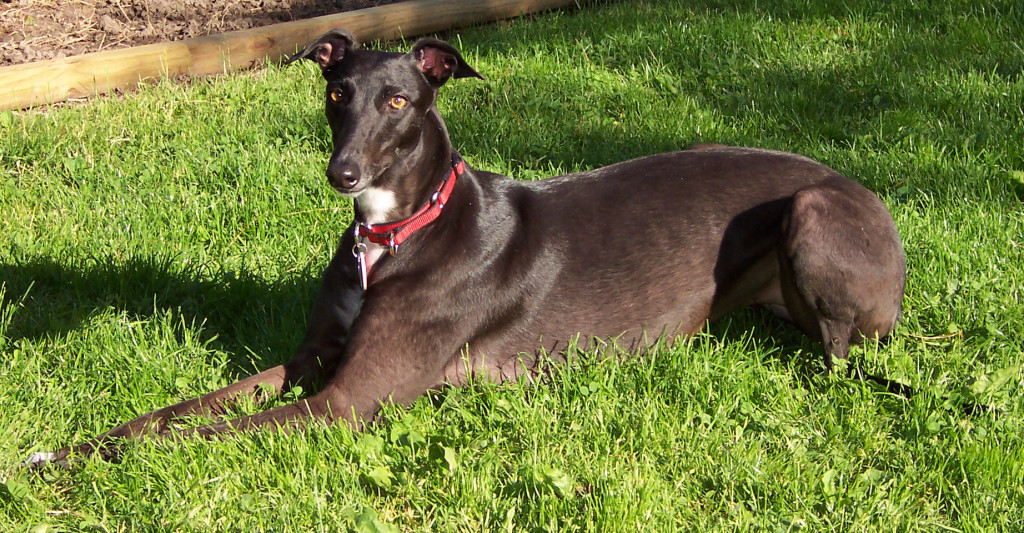
She drew attention whenever we walked her. Familiarity leads to blindness to uniqueness, and we would forget that Valentina trotting by with her narrow head, long snoot, thin legs, and sleek build was so very different from the neighborhood shepherds and retrievers.
“Is that a greyhound?” “Is she a retired racer?” “Is she fast?”
Her unusual greyhound physique was clearly a puzzle for small neighborhood children. One little girl, shortly after learning to talk, waved to Valentina from her wagon calling out “Hi Deer!!” Another little girl, grasping for words, commented to her Dad, “That dog is… FLAT.”
Occasionally I would be driving home from work late and The Husband would already be walking Valentina. From the street I would see her with new eyes, as surely passersby always saw her: she was impossibly sleek, with a gracefully lowered head, and a regal gait. She was beautiful.
Her weight peaked at about 58-60 lbs. in her prime, but in her twilight her increasingly sedentary lifestyle (yes, she got lazier) led to loss of muscle mass and she was under 50 lbs. in her last year. Age had turned her face very gray, and her muzzle nearly white. But she was still a beautiful dog.
Our Fur Baby
For a long time I resisted the notion that I was somehow a mother to my pets. After years of picking up toys strewn around the living room, nursing cut paws and legs, butt wiping, barf cleaning, and generally lamenting that I couldn’t have nice things, I realized I had more in common with motherhood than I wanted to admit.
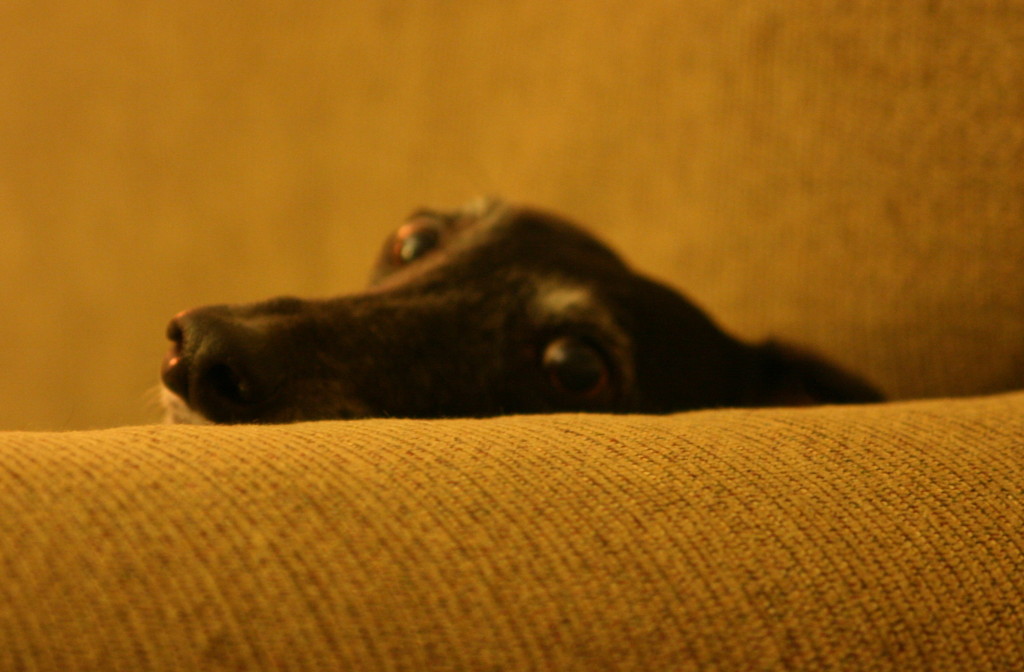
The issue was clinched at the realization that we not only owned three types of coats and three types of shoes for Valentina, I actually dressed her in these articles. Out of necessity. The shoes were especially fun.
The necessity came from the greyhound’s unique physique. Very little body fat, thin skin, and a sparse coat mean very little insulation. The rule of thumb was, if it was chilly enough for me to want a jacket, then Valentina would need one, too.
The greyhound paw is designed for speed; long toes are drawn together with the heel pad, making their feet nimble but not very rugged. In fact, the long toes drawn together conceal a void between the pads. A few times while out on her walk, Valentina stopped cold and lifted a foot. Our first thought was she must have cut her pad on a rock or glass. Nope. Usually it was some object caught in the void between her toepads. Often a ball of ice, one time it was nearly an entire black walnut shell, another time a small pine cone!
NOT Needy
Valentina was not needy at all. Most dogs at least get a little excited when you leave and come home. Not Valentina. She was really quite aloof, but after experiencing my sister’s golden retriever and chocolate lab, non-needy Valentina was exactly the right dog for us.
We might have trained her to keep calm by not making a big deal when we left and came in. It was part of the cautions that the greyhound adoption group suggested; since your newly adopted greyhound has probably NEVER been completely alone before, try to make the transition smooth. Leave by giving a treat and exiting quietly, return casually and don’t call your grey immediately.
It worked. So well that she not only never came running when we came home, but she never even got up from the couch. She might perk up and look at you if you stuck your head into the living room, but even that waned as the years went on. As an elderly dog, we would be lucky if she opened one eye to look at us when we came home. Valentina was always reserved and perfectly sure of herself.
Remembering a long life
There is so much more I could write about Valentina. Her story is long and overwhelming. She had strong primal dog instincts of hole digging and marking, but was equally dedicated to her domestic lifestyle of sleeping, eating, and playing with stuffed toys. She smelled great, owing to her light, short, non-oily greyhound coat. Really, I could kiss her forehead and inhale that Valentina fragrance all day. I miss it terribly.
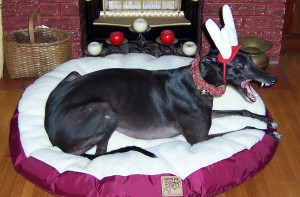
Despite being told that greyhounds thrive on routine, Valentina always preferred variety. From her food to her walks, she liked change. The same walking route all the time didn’t work, but it took several frustrating incidents of her ‘statue routine’ for us to get the message. She would stand stock still and, at 50 lbs of solid muscle, she wasn’t moving unless it was in a different direction than her last walk. She finally settled into a morning route and an evening route – which together made a perfect circular perimeter with our house at the center.
In her youth, Valentina’s greatest adversaries were the vacuum cleaner and the lawn mower. She tried to ‘save’ me from each of these foes a few times, the only times she moved as fast as chasing a squirrel.
She was once attacked by a loose dog and almost died. I’d rather not go into detail here as it was as traumatizing for me as it was for her. She had physical scars, and we both had emotional scars.
She ate dirt as well as grass. And once ate a dead baby bird, swallowing it in one gulp, much to my horror. If you heard her playing in another room, she would stop and pretend like she wasn’t playing if you walked in to watch. When she drank water, it slopped everywhere (our hardwoods now need to be refinished.) The day we took her for a walk in the woods was a revelation; she bounded over logs and up hills like it was her destiny. She was truly a different dog in the woods. We regret that routinely encountering loose dogs on the trail put an end to those adventures.
Valentina didn’t like riding in the car, except for one long road trip to Boston to see her old friend Ernee Beagle. She tried to stand in the car, but had terrible balance, so every turn or acceleration was at a super-slow speed. She loved to lay in the grass. Completely at ease, sunbathing one side then the other. She was oblivious to boundaries, standing on and destroying so many tender plants and flowers in our garden as she snuffled along. Last summer she routinely walked through ONLY the new grass area around our new patio.
She hardly ever barked, but when she did it was the typical greyhound ‘Woo-Roo!’ Many mornings started with the high-pitched version of her ‘woos’, followed by a run down the stairs that sounded like a loose bowling ball.
Uncommon Longevity
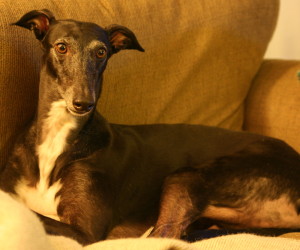
Valentina’s decline was slow and protracted, and, as is the case with a gradual deterioration, we were unaware of how bad it was. Until we saw our Aunt’s reaction the last time she watched Valentina. Aunt Lorna had watched Valentina during nearly every vacation we took over a decade. The last time, last August, Valentina could barely get around. Somehow, we didn’t noticed the gravity of the situation until we saw her in another setting.
Valentina had corns on the pads of three of four feet. Arthritis had hobbled her, too. After nearly a year of different medications at increasing doses, we came to a crossroads. At 13 years and 10 months, Valentina was very, very old for a greyhound, and close to tying the record for oldest greyhound placed by Greyhound Adoption of Greater Rochester.
She had not the strength to climb the staircase to get to our bedroom and her crate. She had some accidents of #2 in the house that seemed like she didn’t know even happened. And, the three stairs leading to outside were a four-times-daily challenge for both of us.
It wasn’t the arthritis after all. The scuffing feet was the final giveaway to spinal degeneration. There was no medicine or therapy that would stop that decline. We were told she would eventually, and painfully, lose the ability to walk as well as all bowel and bladder control.
It was time. We couldn’t let her go on like that. We couldn’t watch our beautiful, graceful Valentina struggling and in pain anymore. The look in her eyes was so, so weary. And winter was coming.
Winters 2014 and 2015 were terrible for her. We chose a day in late fall, a beautiful, sunny, calm day that belied the November calendar. I made her favorite browned ground beef and fed her often that weekend and that day. An hour before the Doctor was due, we helped her outside for one last bask in the sunshine, one last sniff of the air and the grass.
Valentina came inside right to one of her soft beds, as usual. She just stared at the doctor with her big brown eyes, like she did at anyone who came to the house. I don’t think she even felt the needle. The Husband and I both pet her as her eyelids grew heavy and she lay her head down. Her breathing slowed. We told her to go find Elsa, Moby, and Ernee. Valentina gave one last exhaling sigh, and was still.
Though this winter has turned out to be record-breaking mild, we are at peace with letting her go in the fall. Valentina was the best dog, and we loved her so, so much.
Epilogue.
We are completely pet free for the first time ever. It’s been nice to have the freedom to take spontaneous road trips and not have to rush home during a tight schedule. But we miss seeing Valentina’s big brown eyes staring at us from the couch. I miss hugging a dog.
We agreed to take a break of a year or so before considering another pet. The last two years of nursing two elderly pets is still fresh in our minds.
It’s not simply that I miss having a dog or a cat. I miss Valentina, and Elsa. They can’t be replaced. And, we need time to make the space in our hearts for the next dog or cat that picks us, someday.

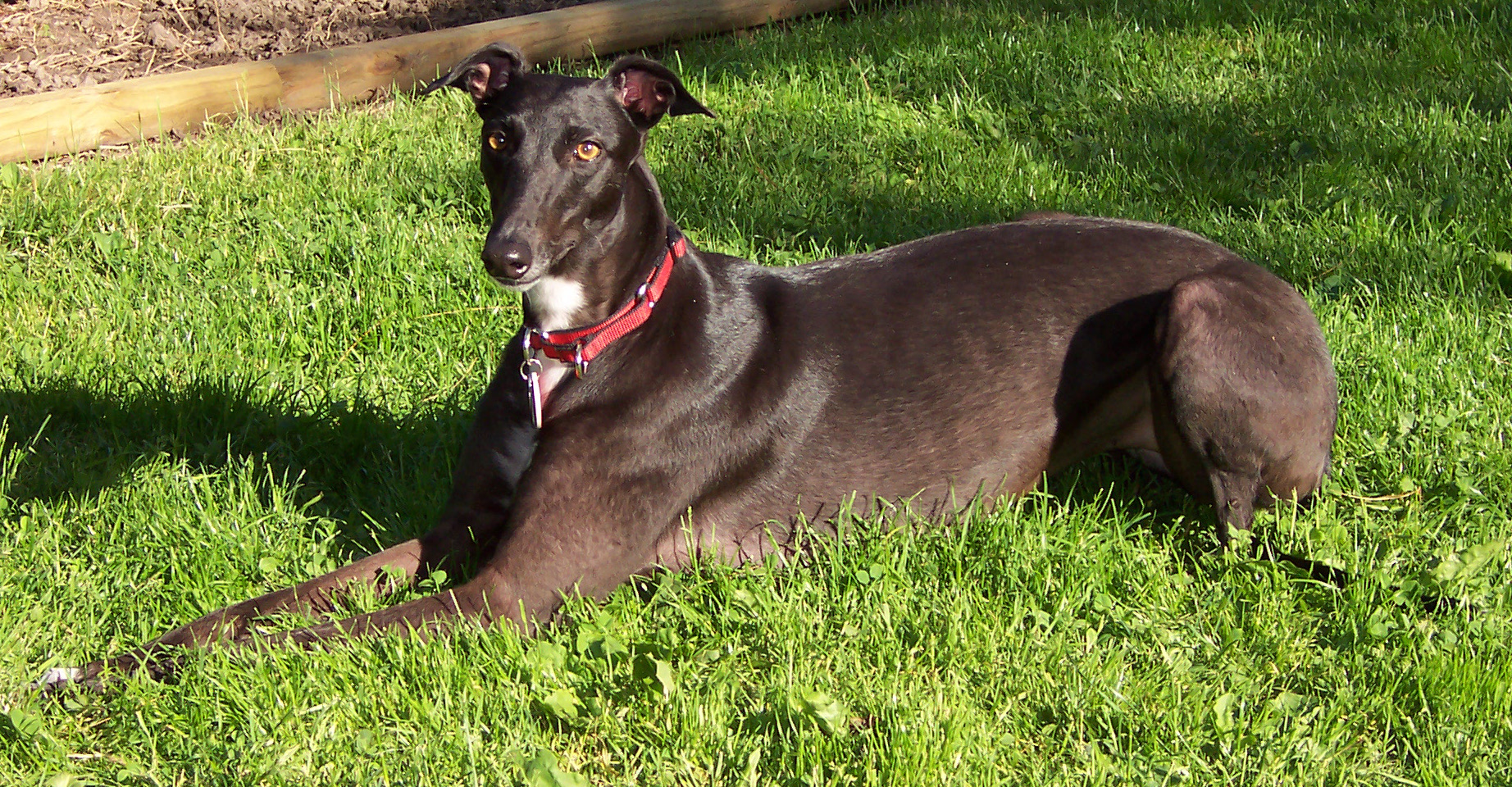
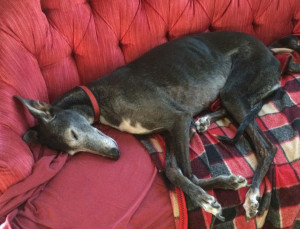
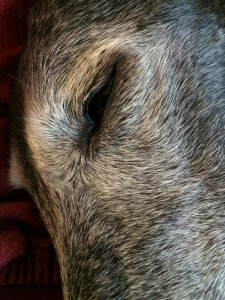
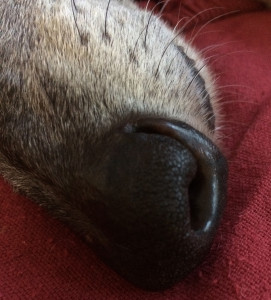
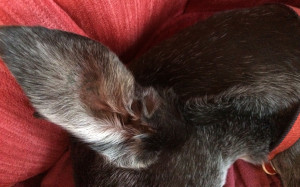
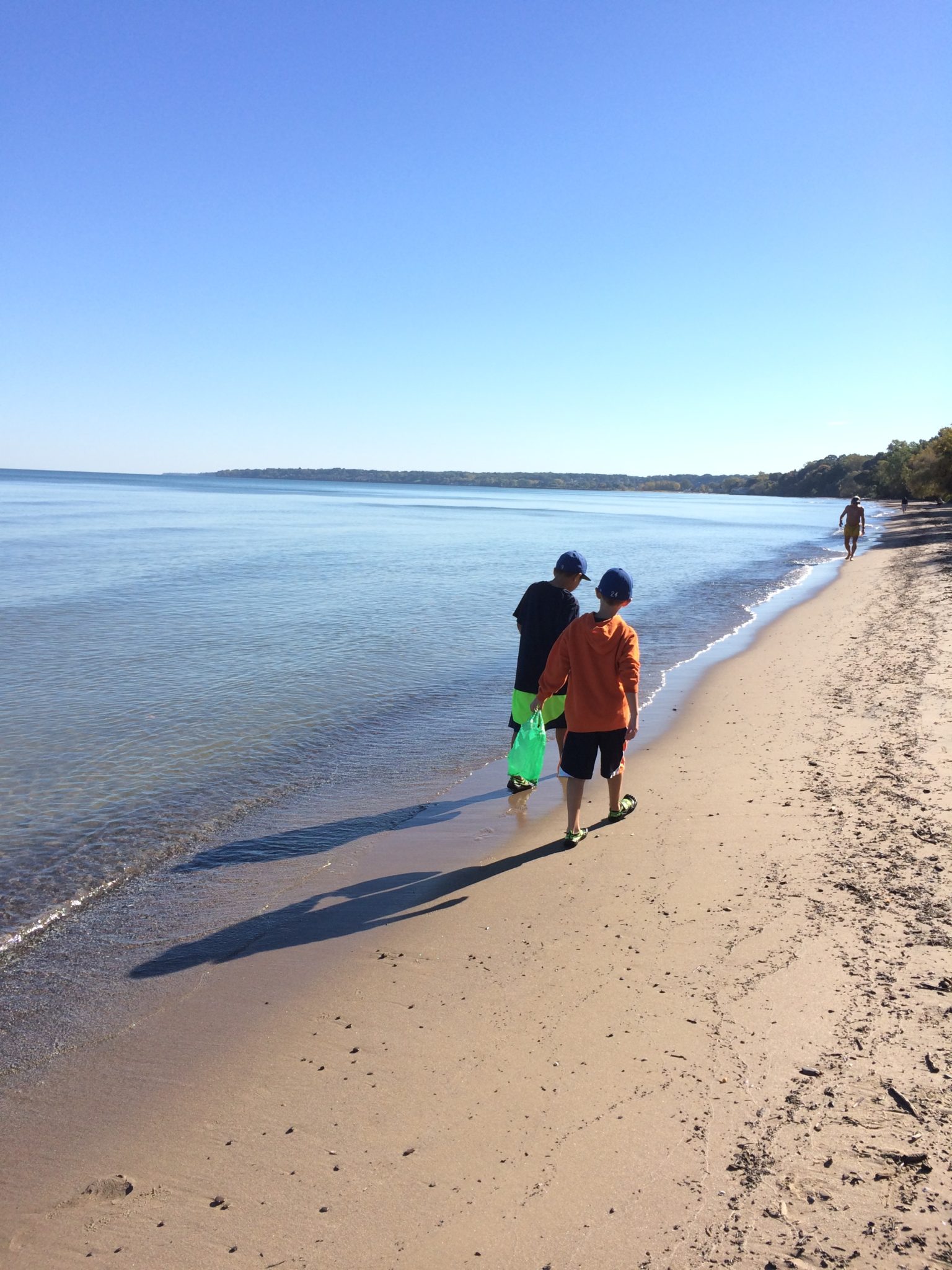 Adventures in Babysitting: Echo of Summer
Adventures in Babysitting: Echo of Summer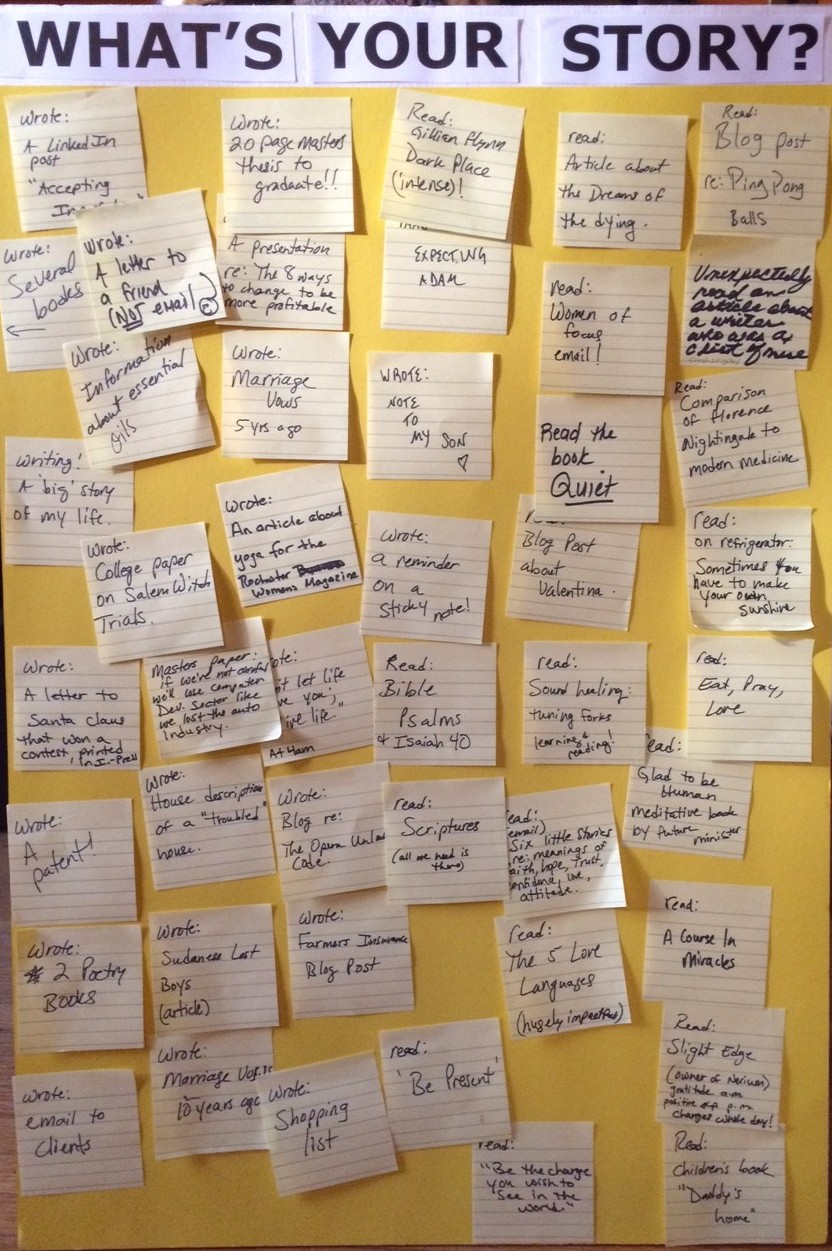

Loved reading about Valentina. They each take a piece of my heart throughout the years. So much love and joy, but it’s also the most heartbreaking pain to say goodbye. XO
You nailed it. It is not only a heartbreaking goodbye, but that piece of our heart they take means we love and miss them for the rest of our lives. Thank you for reading about Ms. V.!
Beautiful. Informative. Heartfelt. Thank you! I especially liked the popcorn story. Tears in my eyes as I finished reading.
Thank you for sharing Valentina’s story. It is beautiful and touched my heart deeply.
Thank you…I know you have a heart for beautiful animals.
Thanks for the moving story of a dog in your life. I was tearful as I read it. It brings memories of wonderful pets I have had and lost. Thank you.
Thank you for reading…I was tearful as I wrote it.
This was beyond wonderful. Have you considered working with an illustrator and creating a children’s book about Valentina? The kinds of details you’ve captured here seem to beg for it. It might be a good project to fill this particular period–so very influenced by great pets but not yet ready to get to know new animals.
Hi Rosemary!! Thank you. You know, I have had an idea for many years about a Valentina story. Now, I have a ‘whole’ story. Thanks for the nudge. And, great hearing from you!
very nice tribute to a beautiful girl may she rest is peace with elsa,moby and ernee very nice terra and mark…
Thanks, Dad. 🙂
Oh Terra…your beautiful story of Valentina made me cry. I missed seeing her so much on Saturday. She was the sweetest dog I ever met and was loved by all who met her.
Thank you, Mare. She was so sweet!
Terra – Having never gotten to meet your fur-baby, I feel like I knew Valentina after reading you beautiful words about her. This was an amazing tribute and I was so moved; you had me in tears. Very well written my friend. Having lost fur-babies of my our, I knew losing her was difficult for you. I understand on a whole new level now after reading your words. Thank you for sharing her journey with us.
Thank you, Valerie. Of course, there was so much more I could have written! She was a regal beauty, but could also be very silly and frisky.